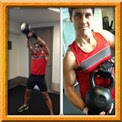Extract:
"HIIT is an efficient way to push the body and the heart rate in a very short amount of time.
But HIIT has to be done in a very specific way: All out.
Think of running from the dinosaurs in Jurassic Park kind of effort.
"You
would have to push yourself to the extreme for that one minute," Hall
said. "You're pushing yourself to like, 'I can barely do any more.' "
One
of the more well-known examples of HIIT is Tabata. It's real simple: 20
seconds of all-out work in an exercise, followed by 10 seconds of rest,
for eight rounds. It sounds like nothing, right? - 4 minutes - until
you do it.
An example would be to do burpees and speed skaters for
20 seconds, alternating between the two, with 10-second rests in
between. If you go as fast as possible and do the full range of motion
(not half jumps), you'll be tired and your heart rate will be high.
Other intervals might be for 30 seconds or 45 seconds followed by a 15-second rest.
If
you start hearing someone talk about 60- or 90-second HIIT intervals,
or if you try to do them and see the effort fall off, it's time to
question if that is HIIT training. It's still good work, of course - but
probably not HIIT.
"I don't know if people can sustain that type
of intensity for 90 seconds - that's really long," Hall said. "I'm not
sure if you can get to your max and hold that for 90 seconds. You want
to feel like you can barely do any more, not that you're plodding
along."
Full article: link










